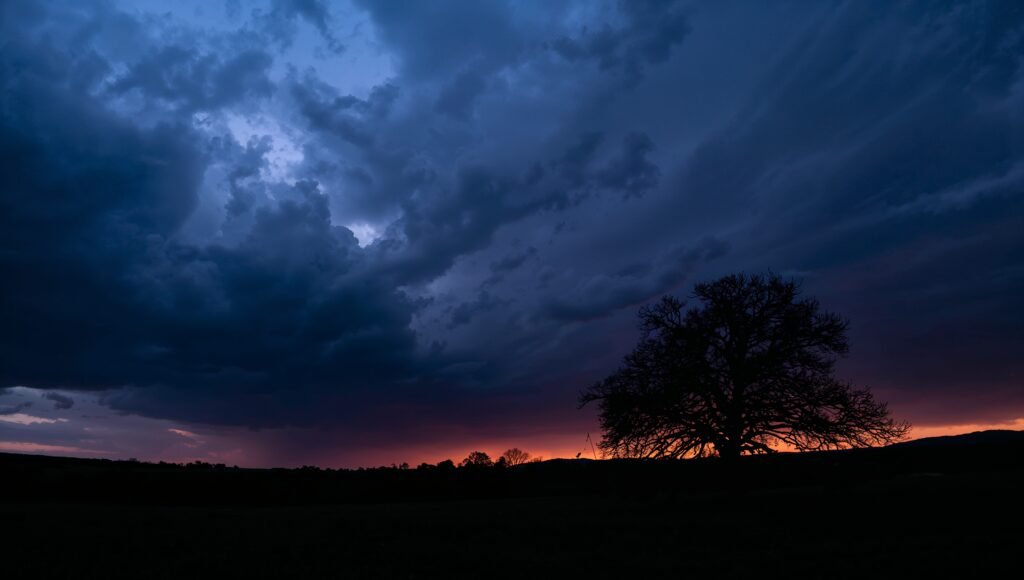The Midnight Horror Theater
The bedroom falls silent except for the hum of the air conditioner and the distant whisper of late-night traffic, and suddenly your mind becomes a horror movie theater where every mundane worry transforms into catastrophic possibility. The presentation tomorrow becomes a public humiliation, the mild headache becomes a tumor, the friend who didn’t text back becomes evidence of irreparable relationship damage. Sleep hovers just out of reach while your brain produces an endless stream of disaster scenarios with the dedication of a Hollywood screenwriter on deadline.
This nightly ritual of catastrophic thinking feels like self-torture, yet it happens with such regularity that it must serve some evolutionary purpose buried deep in our ancestral programming. The caveman brain that once scanned shadows for predators now scans email inboxes for signs of professional doom, applies the same hypervigilance that kept our ancestors alive to modern threats that exist mostly in the realm of possibility. The mechanism designed to detect genuine danger has become a runaway anxiety machine, manufacturing threats faster than reality can disprove them.
The darkness itself becomes an accomplice in this mental conspiracy. When the visual world disappears, the imagination fills the void with phantoms more vivid than any reality. Colors drain from the room, but your mind paints elaborate scenes of failure and loss in high definition. The absence of external stimulation forces attention inward, where every worry gets amplified by the echo chamber of midnight thoughts. What seemed manageable in daylight becomes insurmountable in the theater of shadows.
When Horizontal Becomes Vulnerable
There’s something about horizontal surrender that makes the mind rebel against peace. Lying down signals vulnerability to some primitive part of the brain that equates stillness with exposure. The body prepares for rest, but the mind stages its last stand, conjuring threats to justify its continued vigilance. Sleep represents a temporary death of consciousness, and perhaps these worst-case scenarios are the mind’s way of clinging to wakefulness, creating urgency where none exists to avoid the small surrender that rest requires.
The scenarios follow predictable patterns – health catastrophes, relationship failures, professional disasters, financial ruin. Each worry gets treated with the same urgent attention regardless of its actual probability. The mind makes no distinction between imagining your loved ones in car accidents and worrying about running out of milk, applying the same emotional weight to both. This democratic distribution of anxiety means that genuine concerns get lost in the noise of manufactured crisis, real threats obscured by phantom ones.
Morning always brings perspective that midnight lacks, revealing the absurdity of three AM terrors that felt so convincing in the dark. Problems that seemed impossible to solve become manageable again with daylight. The tumor was a tension headache, the relationship crisis was a dead phone battery, the career catastrophe was a single bad day blown out of proportion. Yet by the next evening, the cycle begins again, memory apparently unable to learn from its own false alarms.
The Democracy of Imagined Disasters
The body responds to imagined threats as if they were real, heart racing over scenarios that exist only in thought. Adrenaline courses through your veins because your mind convinced your nervous system that danger is imminent, even though you’re lying safely in your own bed surrounded by familiar objects. The physiological response to imaginary crisis creates real stress, genuine exhaustion from battling enemies that exist only in the theater of possibility.
Perhaps this midnight catastrophizing serves as a strange form of preparation, mental rehearsal for disasters that might never come. By imagining worst-case scenarios, the mind creates contingency plans, practices responses to theoretical threats. It’s a kind of psychological insurance policy, betting that preparing for disaster will somehow prevent it, or at least reduce its impact if it arrives. The anxiety becomes a superstitious ritual, trading peace for the illusion of control.
Social media and news consumption feed this beast of nocturnal worry, providing endless examples of things that can go wrong in other people’s lives. Each tragic story becomes potential evidence that similar disasters await you, every headline another script for your midnight horror theater. The brain struggles to distinguish between information and instruction, treating news about distant catastrophes as personal warnings rather than random events happening to other people.
The cruel irony is that most of these imagined disasters would actually be survivable if they occurred. Humans are remarkably adaptable creatures, capable of weathering storms they never thought they could handle. Yet the anticipatory suffering often exceeds the actual pain of real problems when they arise. We torture ourselves with imaginary versions of difficulties that might never happen, or that if they did, we would somehow find the strength to endure. The fear of future pain becomes more debilitating than present reality, the imagination a source of suffering rather than escape.
In those quiet moments before dawn, when exhaustion finally overtakes anxiety, there’s sometimes a recognition that most of what we fear exists only in the space between our ears. The worst-case scenarios that seemed so vivid and urgent fade like smoke, leaving behind the simple truth that this moment, right now, is actually fine. The disasters are scheduled for tomorrow or next week or someday, but never quite manage to arrive in the present tense where life actually happens.

Share Your Reflection
Your insights enrich our collective understanding. What thoughts does this spark in your mind?